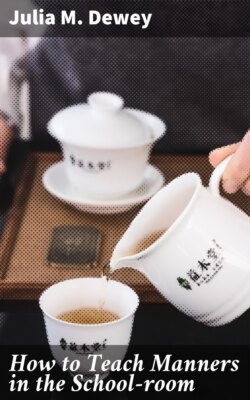Читать книгу How to Teach Manners in the School-room - Julia M. Dewey - Страница 6
На сайте Литреса книга снята с продажи.
GENERAL DIRECTIONS FOR TEACHING MANNERS.
ОглавлениеTable of Contents
1. In teaching manners to young children there is no better example to be followed than that of a careful mother, who takes advantage of incidents of every-day life to impress a truth upon the mind of her child. By such means the ideal standard is kept in close relation to the child’s conduct until it is taken up and assimilated into his nature. For this reason it is better to begin the definite teaching of manners with reference to the school, and as far as possible to allow actual occurrences to suggest or illustrate the point to be considered. The lesson that will fit the needs of the occasion is the most effective. Just here it may be remarked that, within bounds, a teacher is justified in taking advantage of these opportunities, even if it somewhat disturbs the formality of a rigid programme of school-work.
2. The mother’s method may be followed still farther in making the definite lesson as informal as possible. Questions should be asked to awaken thought, and the lesson should partake more of the nature of a familiar conversation than of a school exercise. Pupils should be allowed to tell what they know on certain points, and new truths should be “developed” as in other subjects.
3. The instruction to older pupils may be given in a similar manner, but less simply; or the item may be read with or without comment. This lesson serves to instruct those ignorant of prevailing forms, and to keep the matter before the minds of others who are better informed. When pupils are old enough, if not provided with a text-book on manners, it is well for them to make a note of the directions given.
4. The time given to this subject must be regulated by the other work in the school. A few minutes daily will amount to a great deal in the course of years.
5. A plan that has been successfully pursued is to allow ten minutes for the opening exercises of school, and to make a brief lesson in manners a part of these exercises. It is not the aim of the author that the illustrative lessons shall be arbitrarily followed. That would be to aim at an impossibility. If success is expected, it is even more necessary in this branch than in others that the work be stamped with the individuality of the teacher. There must also be a certain compass of expression and force and earnestness of manner in giving these lessons which cannot be imparted to the printed page.
6. Brevity is essential, as the effect sought would be lost if the lesson became tiresome. Moreover, it is not intended to add to the already overburdened curriculum of most schools. Teachers should exercise care in selecting items adapted to the age and capacity of their pupils. It is needless to add that as far as there is opportunity teachers should see that precept and practice go hand-in-hand.
